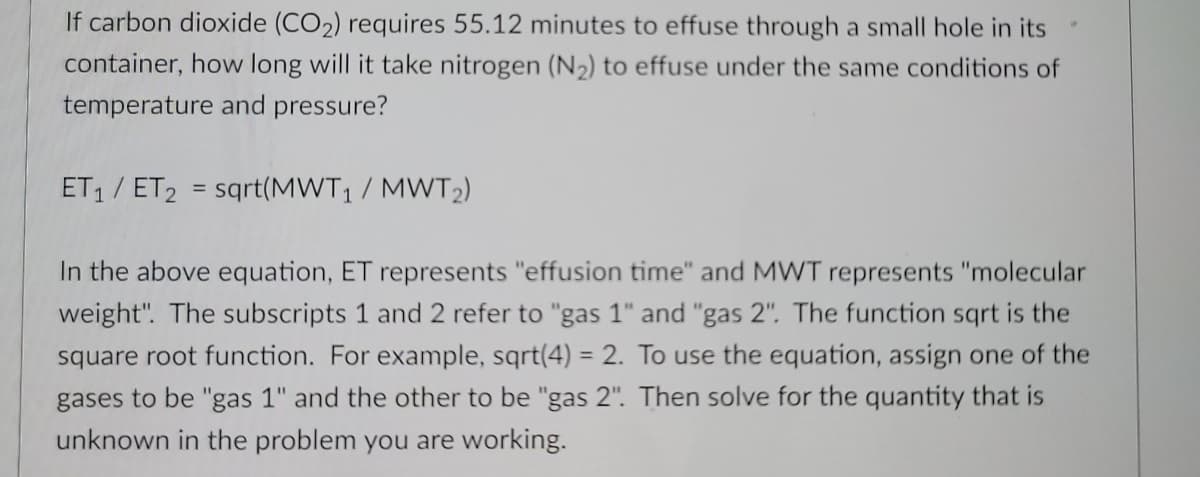If carbon dioxide (CO2) requires 55.12 minutes to effuse through a small hole in its container, how long will it take nitrogen (N2) to effuse under the same conditions of temperature and pressure? ET1 / ET2 = sqrt(MWT1 / MWT2) In the above equation, ET represents "effusion time" and MWT represents "molecular weight". The subscripts 1 and 2 refer to "gas 1" and "gas 2". The function sqrt is the square root function. For example, sqrt(4) = 2. To use the equation, assign one of the %3D gases to be "gas 1" and the other to be "gas 2". Then solve for the quantity that is unknown in the problem you are working.
If carbon dioxide (CO2) requires 55.12 minutes to effuse through a small hole in its container, how long will it take nitrogen (N2) to effuse under the same conditions of temperature and pressure? ET1 / ET2 = sqrt(MWT1 / MWT2) In the above equation, ET represents "effusion time" and MWT represents "molecular weight". The subscripts 1 and 2 refer to "gas 1" and "gas 2". The function sqrt is the square root function. For example, sqrt(4) = 2. To use the equation, assign one of the %3D gases to be "gas 1" and the other to be "gas 2". Then solve for the quantity that is unknown in the problem you are working.
Chapter5: Gases
Section: Chapter Questions
Problem 143CWP: A certain flexible weather balloon contains helium gas at a volume of 855 L. Initially, the balloon...
Related questions
Question

Transcribed Image Text:If carbon dioxide (CO2) requires 55.12 minutes to effuse through a small hole in its
container, how long will it take nitrogen (N2) to effuse under the same conditions of
temperature and pressure?
ET1 / ET2 = sqrt(MWT1 / MWT2)
In the above equation, ET represents "effusion time" and MWT represents "molecular
weight". The subscripts 1 and 2 refer to "gas 1" and "gas 2". The function sqrt is the
square root function. For example, sqrt(4) = 2. To use the equation, assign one of the
%3D
gases to be "gas 1" and the other to be "gas 2". Then solve for the quantity that is
unknown in the problem you are working.
Expert Solution
This question has been solved!
Explore an expertly crafted, step-by-step solution for a thorough understanding of key concepts.
This is a popular solution!
Trending now
This is a popular solution!
Step by step
Solved in 2 steps with 2 images

Knowledge Booster
Learn more about
Need a deep-dive on the concept behind this application? Look no further. Learn more about this topic, chemistry and related others by exploring similar questions and additional content below.Recommended textbooks for you


Chemistry
Chemistry
ISBN:
9781305957404
Author:
Steven S. Zumdahl, Susan A. Zumdahl, Donald J. DeCoste
Publisher:
Cengage Learning

Chemistry: An Atoms First Approach
Chemistry
ISBN:
9781305079243
Author:
Steven S. Zumdahl, Susan A. Zumdahl
Publisher:
Cengage Learning


Chemistry
Chemistry
ISBN:
9781305957404
Author:
Steven S. Zumdahl, Susan A. Zumdahl, Donald J. DeCoste
Publisher:
Cengage Learning

Chemistry: An Atoms First Approach
Chemistry
ISBN:
9781305079243
Author:
Steven S. Zumdahl, Susan A. Zumdahl
Publisher:
Cengage Learning

Chemistry: Principles and Reactions
Chemistry
ISBN:
9781305079373
Author:
William L. Masterton, Cecile N. Hurley
Publisher:
Cengage Learning

Chemistry for Engineering Students
Chemistry
ISBN:
9781337398909
Author:
Lawrence S. Brown, Tom Holme
Publisher:
Cengage Learning

General Chemistry - Standalone book (MindTap Cour…
Chemistry
ISBN:
9781305580343
Author:
Steven D. Gammon, Ebbing, Darrell Ebbing, Steven D., Darrell; Gammon, Darrell Ebbing; Steven D. Gammon, Darrell D.; Gammon, Ebbing; Steven D. Gammon; Darrell
Publisher:
Cengage Learning